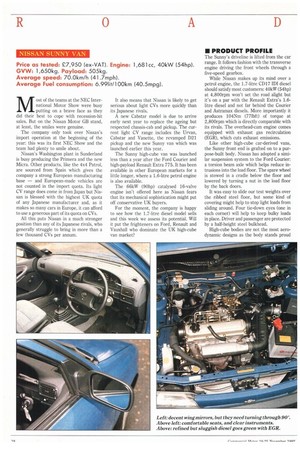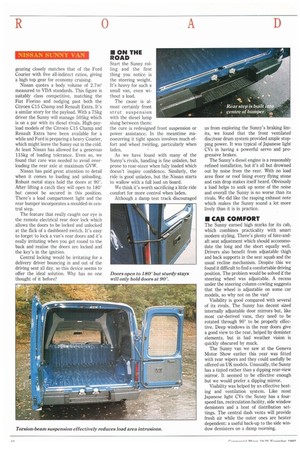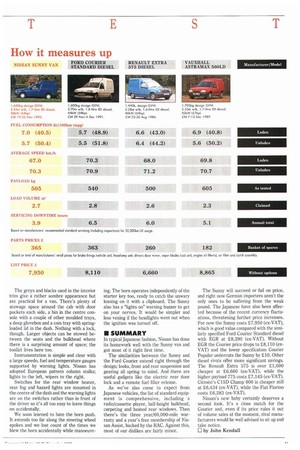NISSAN SUNNY VAN
Page 40

Page 41

Page 42

Page 43

If you've noticed an error in this article please click here to report it so we can fix it.
Price as tested: £7,950 (ex-VAT), Engine: 1,681cc, 40kW (54hp). GVW: 1,650kg. Payload: 505kg.
Average speed: 70.0km/h (41.7mph).
Average Fuel consumption: 6.991it/100km (40.5mpg).
Most of the teams at the NEC International Motor Show were busy putting on a brave face as they did their best to cope with recession-hit sales. But on the Nissan Motor GB stand, at least, the smiles were genuine.
The company only took over Nissan's import operation at the beginning of the year: this was its first NEC Show and the team had plenty to smile about.
Nissan's Washington plant in Sunderland is busy producing the Primera and the new Micra. Other products, like the 4x4 Patrol, are sourced from Spain which gives the company a strong European manufacturing base — and European madevehicles are not counted in the import quota. Its light CV range does come in from Japan but Nissan is blessed with the highest UK quota of any Japanese manufacturer and, as it makes so many cars in Europe, it can afford to use a generous part of its quota on CVs.
All this puts Nissan in a much stronger position than any of its Japanese rivals, who generally struggle to bring in more than a few thousand CVs per annum_ It also means that Nissan is likely to get serious about light CVs more quickly than its Japanese rivals.
A new Cabstar model is due to arrive early next year to replace the ageing but respected chassis-cab and pickup. The current light CV range includes the Urvan, Cabstar and Vanette, the revamped D21 pickup and the new Sunny van which was launched earlier this year.
The Sunny high-cube van was launched less than a year after the Ford Courier and high-payload Renault Extra 775. It has been available in other European markets for a little longer, where a 1.6-litre petrol engine is also available.
The 66kW (90hp) catalysed 16-valve engine isn't offered here as Nissan fears that its mechanical sophistication might put off conservative UK buyers_ For the moment, the company is happy to see how the 1.7-litre diesel model sells and this week we assess its potential. Will it put the frighteners on Ford, Renault and Vauxhall who dominate the UK high-cube van market?
• PRODUCT PROFILE
The Sunny's driveline is lifted from the car range. It follows fashion with the transverse engine driving the front wheels through a five-speed gearbox.
While Nissan makes up its mind over a petrol engine, the 1.7-litre CD17 IDI diesel should satisfy most customers: 40kW (54hp) at 4,800rpm won't set the road alight but it's on a par with the Renault Extra's 1.6litre diesel and not far behind the Courier and Astramax diesels. More importantly it produces 104Nm (771bft) of torque at 2,800rpm which is directly comparable with its rivals. The overhead-cam engine comes equipped with exhaust gas recirculation (EGR), which cuts exhaust emissions.
Like other high-cube car-derived vans, the Sunny front end is grafted on to a purpose-built body. Nissan has adopted a similar suspension system to the Ford Courier: a torsion beam axle which helps reduce intrusions into the load floor. The spare wheel is stowed in a cradle below the floor and lowered by turning a nut in the load floor by the back doors.
It was easy to slide our test weights over the ribbed steel floor, but some kind of covering might help to stop light loads from sliding around. Four tie-down eyes (one in each corner) will help to keep bulky loads in place. Driver and passenger are protected by a half-height steel bulkhead.
High-cube bodies are not the most aerodynamic designs as the body stands proud of the cab roof. Even so, Nissan claims a drag coefficient of 0.34, which is competitive with many cars.
• PRODUCTIVITY
It's a long time since we've encountered foul weather on our Kent light vehicle test route; a fact which obviously hadn't passed unnoticed because this outing made up for it. Maybe that was made inevitable by the name on the door. Strong winds and torrential rain didn't do our results any good and condemned the laden Sunny to an unremarkable 7.0lit/100km (40.5mpg). These days we expect better from a light diesel and our unladen result, recorded in better weather, is a pointer toward its potential. This time round the Sunny returned 5.71it/100km (50.4mpg), which is more in keeping with its competitors. Normally we expect to use around 10% more fuel on the laden run and on that basis the Sunny would have returned 61it/100km (45mpg) on its laden run which is well within the frame compared with its rivals.
The Nissan isn't that quick against the stopwatch; doubtless a product of modest power and well-spaced gear ratios. The ■ gearing closely matches that of the Ford Courier with five all-indirect ratios, giving a high top gear for economy cruising.
Nissan quotes a body volume of 2.7m' measured to VDA standards. This figure is suitably class competitive, matching the Fiat Fiorino and nudging past both the Citroen C15 Champ and Renault Extra. It's a similar story for the payload. With a 75kg driver the Sunny will manage 505kg which is on a par with its diesel rivals. High-payload models of the Citroen C15 Champ and Renault Extra have been available for a while and Ford is preparing a heavy Courier, which might leave the Sunny out in the cold. At least Nissan has allowed for a generous 115kg of loading tolerance. Even so, we found that care was needed to avoid overloading the rear axle at maximum GVW.
Nissan has paid great attention to detail when it comes to loading and unloading. Robust metal stays hold the doors at 90°. After lifting a catch they will open to 1800 but cannot be secured in this position. There's a load compartment light and the rear bumper incorporates a moulded-in central step.
The feature that really caught our eye is the remote electrical rear door lock which allows the doors to be locked and unlocked at the flick of a dashboard switch. It's easy to forget to lock a van's rear doors and it's really irritating when you get round to the back and realise the doors are locked and the key's in the ignition.
Central lacking would be irritating for a delivery driver bouncing in and out of the driving seat all day, so this device seems to offer the ideal solution. Why has no one thought of it before?
• ON THE ROAD
Start the Sunny rolling and the first thing you notice is the steering weight. It's heavy for such a small van, even without a load.
The cause is almost certainly front strut suspension with the diesel lump slung between them: the cure is redesigned front suspension or power assistance. In the meantime manoeuvring it tight spaces involves much effort and wheel twirling, particularly when laden.
As we have found with many of the Sunny's rivals, handling is fine unladen, but prone to rear-steer when fully loaded which doesn't inspire confidence. Similarly, the ride is good unladen, but the Nissan starts to wallow with a full load on board.
We think it's worth sacrificing a little ride comfort for more control when laden.
Although a damp test track discouraged us from exploring the Sunny's braking limits, we found that the front ventilated disc/rear drum system provided ample stopping power. It was typical of Japanese light CVs in having a powerful servo and progressive brakes.
The Sunny's diesel engine is a reasonably refined installation, but it's all but drowned out by noise from the rear. With no load area floor or roof lining every flying stone and rain drop makes itself heard. Obviously a load helps to soak up some of the noise and overall the Sunny is no worse than its rivals, We did like the rasping exhaust note which makes the Sunny sound a lot more lively than it is in practice.
• CAB COMFORT
The Sunny earned high marks for its cab, which combines practicality with smart modern styling. There's plenty of fore-andaft seat adjustment which should accommodate the long and the short equally well. Drivers also benefit from adjustable thigh and back supports in the seat squab and the usual recline mechanism. Despite this we found it difficult to find a comfortable driving position. The problem would be solved if the steering wheel was adjustable. A recess under the steering column cowling suggests that the wheel is adjustable on some car models, so why not on the van?
Visibility is good compared with several of its rivals. The Sunny has decent sized internally adjustable door mirrors but, like most car-derived vans, they need to be rotated through 900 to be properly effective. Deep windows in the rear doors give a good view to the rear, helped by demister elements, but in bad weather vision is quickly obscured by muck.
The Sunny van we saw at the Geneva Motor Show earlier this year was fitted with rear wipers and they could usefully be offered on UK models. Unusually, the Sunny has a tinted rather than a dipping rear-view mirror. It seemed to be effective enough but we would prefer a dipping mirror.
Visibility was helped by an effective heating and ventilation system. Like most Japanese light CVs the Sunny has a fourspeed fan, recirculation facility, side window demisters and a host of distribution settings. The central dash vents will provide fresh air while the outer ones are heater dependent: a useful back-up to the side window demisters on a damp morning.
The greys and blacks used in the interior trim give a rather sombre appearance but are practical for a van. There's plenty of stowage space around the cab with door pockets each side, a bin in the centre console with a couple of other moulded trays, a deep glovebox and a coin tray with springloaded lid in the dash. Nothing with a lock, though. Larger objects can be stowed between the seats and the bulkhead where there is a surprising amount of space; the toolkit lives here too.
Instrumentation is simple and clear with a large speedo, fuel and temperature gauges supported by warning lights. Nissan has adopted European pattern column stalks; lights to the left, wipers to the right.
Switches for the rear window heater, rear fog and hazard lights are mounted in the centre of the dash and the warning lights are on the switches rather than in front of the driver so it's all too easy to leave things on accidentally.
We soon learned to hate the horn push. It extends too far along the steering wheel spokes and we lost count of the times we blew the horn accidentally while manoeuvr
ing. The horn operates independently of the starter key too, ready to catch the unwary leaning on it with a clipboard. The Sunny also has a "lights on" warning buzzer to get on your nerves. It would be simpler and less vexing if the headlights went out when the ignition was turned off.
• SUMMARY
In typical Japanese fashion, Nissan has done its homework well with the Sunny van and got most of it right first time.
The similarities between the Sunny and the Ford Courier extend right through the design; looks, front and rear suspension and gearing all spring to mind. And there are useful gadgets like the electric rear door lock and a remote fuel filler release.
As we've also come to expect from Japanese vehicles, the list of standard equipment is comprehensive, including a radio/cassette player, half-height bulkhead, carpeting and heated rear windows. Then there's the three year/60,000-mile warranty and a year's free membership of Nissan Assist, backed by the RAC. Against this, most of our dislikes are fairly minor.
The Sunny will succeed or fail on price, and right now German importers aren't the only ones to be suffering from the weak pound. The Japanese have also been affected because of the recent currency fluctuations, threatening further price increases. For now the Sunny costs £7,950 (ex-VAT), which is good value compared with the similarly specified Ford Courier Standard diesel with EGR at £8,390 (ex-VAT). Without EGR the Courier price drops to £8,110 (exVAT) and the lower specification Courier Popular undercuts the Sunny by £10. Other diesel rivals offer more significant savings. The Renault Extra 575 is over £1,000 cheaper at £6,660 (ex-VAT), while the higher payload 775 costs £7,145 (ex-VAT). Citroen's C15D Champ 600 is cheaper still at £6,434 (ex-VAT), while the Fiat Fiorino costs £6,283 (ex-VAT).
Nissan's new baby certainly deserves a second look. It's a close match for the Courier and, even if its price rules it out of volume sales at the moment, rival manufacturers would be well advised to sit up and take notice.
by John Kendall
















































































